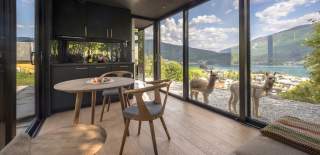Green Travel Sognefjord
This article invites you to explore the wonders of Sognefjord through the lens of sustainable travel.
Tourism, while a catalyst for economic growth, often comes with its own set of challenges, including environmental degradation and cultural erosion. Choosing green travel is a conscious decision to mitigate these challenges and contribute to a sustainable future.
Sognefjord takes pride in going the extra mile to ensure that your visit not only enriches your personal experiences but also nurtures the local community and preserves the region's unique cultural heritage.
Green Travel Certifications:
Sognefjord boasts a lineup of companies and products that have achieved various prestigious green travel certifications, underscoring the region's commitment to responsible tourism. These certifications include:
-
Ecotourism Norway: This certification ensures that tourism activities in Sognefjord are conducted in a manner that minimizes environmental impact while promoting conservation and community involvement.
-
ISO 14001: Companies adhering to ISO 14001 standards demonstrate a commitment to effective environmental management systems, emphasizing continuous improvement in environmental performance.
-
The Ecolabel Nordic Swan: A symbol of environmental excellence, the Nordic Swan ensures that products and services in Sognefjord meet stringent criteria for sustainability and eco-friendliness.
-
Green Key: Accommodations and attractions with the Green Key certification prioritize environmental responsibility, offering travelers an eco-friendly choice without compromising on quality.
-
Eco-Lighthouse: This certification is a testament to businesses in Sognefjord actively working towards sustainability, implementing measures to reduce their ecological footprint.
Benefits of Choosing Green:
By aligning your travel choices with these certified businesses and products, you not only contribute to the preservation of Sognefjord's natural beauty but also engage in a more meaningful travel experience. Sustainable tourism ensures that the delicate balance of ecosystems is maintained, enabling future generations to revel in the wonders of this enchanting region.
Exploring Sognefjord Responsibly:
As you embark on your green travel adventure in Sognefjord, consider activities that immerse you in the local culture and heritage while minimizing your environmental impact. Opt for guided tours led by knowledgeable locals who share insights into the region's rich history and traditions.
Choose eco-friendly transportation options, such as electric boats, cars, train or bicycles, to explore the fjords and surrounding landscapes.
Getting to Sognefjord is a breeze with a variety of eco-friendly transportation options. Sit back and savor Norway's picturesque views by choosing public transport via coach, boat, car, or rail.
The Bergen Railway offers a scenic journey across the mountains from Oslo or Bergen, while a high-speed boat from Bergen to Sognefjord provides a thrilling alternative. Let someone else take the wheel, allowing you to relish the journey and make your holiday more sustainable.
For environmentally aware drivers with electric cars, Sognefjord welcomes you to explore emissions-free. Charging stations are conveniently located in many places, ensuring a hassle-free and green travel experience. Take advantage of the central location of Sognefjord along the E16, E39 or RV5 making it easily accessible and providing a gateway to numerous exceptional excursions.
10 Tips for a Sustainable Holiday in Sognefjord:
-
Use Public Transport: Embrace eco-friendly travel options to reduce your carbon footprint and enjoy Norway's breathtaking landscapes.
-
Choose Sustainable Accommodations: Opt for accommodations that prioritize sustainability and have earned green certifications.
-
Bike Rental: Explore Sognefjord's beauty on two wheels, minimizing your environmental impact.
-
Emission-Free Activities: Engage in activities that leave no carbon footprint, such as electric boat tours or nature hikes.
-
Waste Management: Sort and dispose of your waste responsibly, contributing to the region's cleanliness.
-
Support Local Restaurants: Dine at eateries that source ingredients locally, supporting the community and reducing food miles.
-
Bring Your Own Water Bottle: Refill your reusable water bottle at available locations, minimizing single-use plastic waste.
-
Respect Local Farmers and People: Understand and honor local customs, respecting the people and their way of life.
-
Know Your Right to Roam: Familiarize yourself with the Norwegian "right to roam" in nature, ensuring responsible exploration.
-
Shop Locally: Contribute to the local economy by purchasing goods and souvenirs from nearby businesses.
Sognefjord invites you to not only witness its natural wonders but to do so responsibly and sustainably. By embracing green travel options, choosing certified accommodations, and following our tips, you play a vital role in preserving this region's beauty for future generations. Let your holiday in Sognefjord be a testament to the transformative power of conscious travel, leaving behind cherished memories and a positive impact on the environment.
Sognefjord invites you to not only witness its awe-inspiring beauty but to do so with a commitment to sustainability. By choosing green travel options and supporting certified businesses, you become an integral part of the region's journey toward a brighter and more sustainable future. Let your vacation in Sognefjord be a testament to the transformative power of conscious travel, leaving a positive mark on both the environment and your own memories.
The Norwegian right to roam:
The right to roam applies to open country, sometimes also known as "unfenced land", which is land that is not cultivated. In Norway, the term covers most shores, bogs, forests, and mountains. Small islands of uncultivated land within cultivated land are not regarded as open country.
The right does not apply to “fenced land”, which is private, and includes cultivated land, such as ploughed fields with or without crops, meadows, pastures and gardens, as well as young plantations, building plots and industrial areas.
However, you can access fields and meadows from 15 October to 30 April when the ground is frozen or covered with snow. Note that “fenced land” does not need to actually be fenced.

